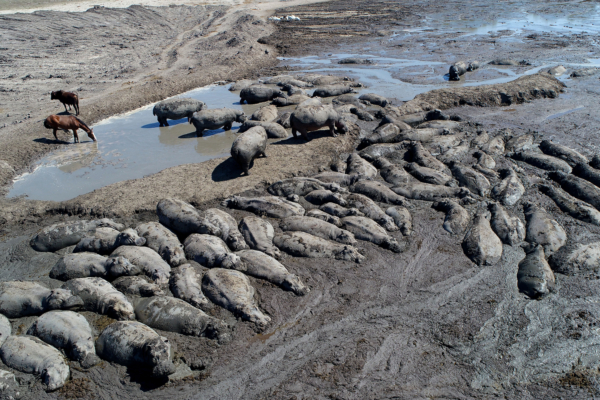Global climate anomalies have led to unprecedented heavy rains and widespread drought in many areas, resulting in food and water scarcity. Due to prolonged drought in southern African countries, the range of culling wild animals has expanded to feed hungry citizens.
The United Nations World Food Programme (UN WFP) stated in June that the southern African region experienced the driest February in a century with rainfall as low as 20% of normal levels. This critical period coincided with the key phase of local crop production.
Currently, countries such as Namibia, Malawi, Lesotho, Botswana, Zambia, and Zimbabwe are facing severe food insecurity and have declared a state of national emergency. Angola, Mozambique, Eswatini, and South Africa are also affected by the drought.
In response, some African governments believe that hunting wild animals can address hunger, alleviate grazing pressure, water scarcity, and reduce conflicts between locals and wildlife in arid regions. It was reported that hundreds of animals died in the region in 2023 due to dwindling water sources.
An aerial survey conducted in 2022 over Angola, Botswana, Namibia, Zambia, and Zimbabwe revealed a population of over 200,000 elephants, representing more than half of the savanna elephant population in Africa.
The Ministry of Environment, Forestry, and Tourism in Namibia announced in late August that due to drought and food shortages, professional hunters were permitted to cull over 700 wild animals in several national parks, including 30 hippos, 60 buffaloes, 83 elephants, 300 zebras, to provide food for the food-insecure population.
In response to the food crisis, over 150 animals have been processed into 125,000 pounds of meat for distribution among the population. Namibia declared a state of emergency as early as May this year, with nearly half of the population facing serious food shortages.
In late September, the Zimbabwe Parks and Wildlife Management Authority announced plans to cull 200 elephants to distribute their meat to those facing food scarcity due to the drought.
The spokesperson for the Zimbabwe Parks and Wildlife Management Authority, Tinashe Farawo, stated that approximately 45,000 elephants reside in the Hwange National Park, exceeding the park’s carrying capacity, necessitating hunting activities in arid areas to address overpopulation.
The Minister of Environment, Climate, Tourism, and Hospitality Industry in Zimbabwe, Sithembiso Nyoni, informed parliament on September 11 that the government plans to emulate Namibia by culling elephants and mobilizing women to process and package the meat for distribution to communities in need of protein.
Conversely, conservationists and individuals have raised concerns about the large-scale elephant culling, warning that such actions could undermine conservation efforts and fail to address the urgent food crisis.
In Namibia, wildlife extends far beyond national parks to areas such as public lands, private game reserves, hunting farms, and mixed farming areas, totaling around 2.5 to 3 million animals, with 80% residing on fenced permanent landholdings.
Landholders with permanent landholding permits annually sell around 15% of springboks to hunters for natural population control. They also promote hunting to customers needing such services to generate additional income and combat poaching.
Opponents argue that regions should relocate surplus elephants to sparsely populated areas through policies, enhanced irrigation facilities, and other methods to allow elephant herds to adapt to changing climates and minimize conflicts with humans, which they deem as the “real” solution.
Kate Evans, founder of the non-profit organization ElephantVoices, expressed concerns regarding the hunting method’s impact on Africa’s complex elephant societies. She warned that hunting could have far-reaching implications on the entire elephant population and reduce genetic diversity.
Chris Brown, CEO of The Namibian Chamber of Environment (NCE), urged the government to protect elephants in arid regions. He emphasized that desert-adapted elephants are scarce, and older elephants pass down knowledge on finding food and water to survive droughts. Additionally, the ecotourism value of elephants far exceeds their meat value, and they play a vital ecological role in the region.
In response to criticisms, Pohamba Shifeta, the Namibian Minister of Environment, Forestry, Tourism, and Agriculture, defended the culling program as necessary to control overpopulated animals and mitigate the effects of drought, citing it as a long-standing practice to address threats to wildlife and humans posed by the drought.
Romeo Muyunda, spokesperson for the Namibian Ministry of Environment, supported the government’s measures to slaughter animals to combat drought, emphasizing the severity of the drought situation and the potential escalation of conflicts without intervention.
The United States Agency for International Development (USAID) has allocated funds multiple times this year to address food shortages and conflicts in African regions, aiming to alleviate local crises.
In a statement in July, USAID highlighted the severe impact of below-average rainfall on crops in Zimbabwe during the growing season. They allocated $39 million to provide drought assistance, aiming to offer food aid to 500,000 people.
Throughout this year, USAID has provided nearly $62 million to Zimbabwe for food aid, agricultural supplies, livestock, and water access. They have also granted $4.9 million to Namibia, aiding approximately 1.4 million people affected by drought from September to July, easing the food scarcity crisis.

